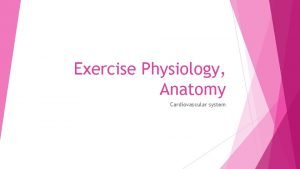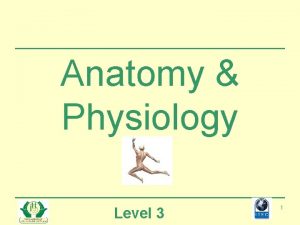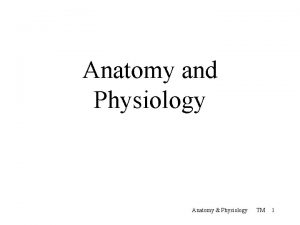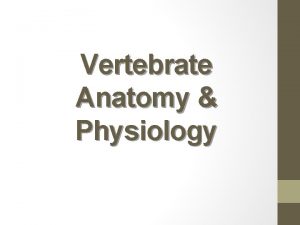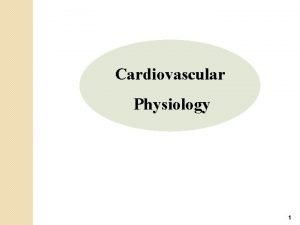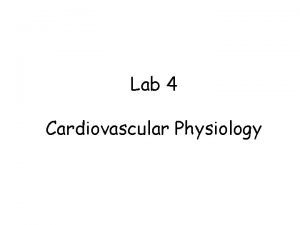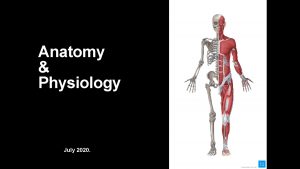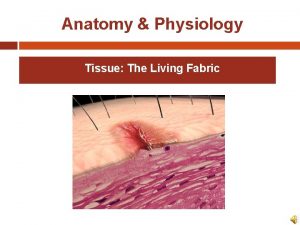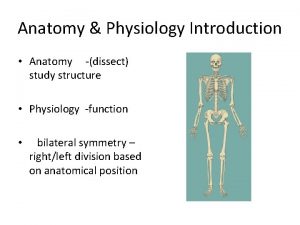Anatomy and Physiology The Cardiovascular System The cardiovascular


































- Slides: 34

Anatomy and Physiology The Cardiovascular System

�The cardiovascular system contains the heart, blood vessels (BVs), and blood. �Its function is to transport oxygen and nutrients throughout the body. It does this by circulating blood. �An average body contains ~5 liters of blood but the heart pumps ~7, 000 liters of blood daily while the heart contracts ~2. 5 billion times in an average lifetime.

The Heart: �This is a powerful pump �It is found in the thoracic (chest) cavity behind the sternum and mediastinum �Average heart size is 14 X 9 cm �It is separated into chambers: 2 right and 2 left (or 2 upper and 2 lower)

�It is covered by the pericardium (a membrane) which has 2 layers: ◦ Visceral pericardium (covers the heart; inner layer); a. k. a. epicardium ◦ Parietal pericardium (covers the visceral pericardium; outer layer) ◦ The pericardial cavity is the space between these layers which contains serous fluid ◦ Pericarditis is inflammation of the pericardium usually caused by viral or bacterial infection.

�This is composed of 3 layers: ◦ Epicardium protects the heart (reduces friction); this contains connective tissue & adipose ◦ Myocardium is the middle layer; contains mostly cardiac tissue ◦ Endocardium is the innermost layer; contains epithelium & connective tissue and elastic & collagenous fibers The Heart Walls

Heart Chambers and Valves: �There are 4 chambers: ◦ The atria (sing. atrium) receive blood ◦ The ventricles send blood (from the atria) �The right & left chambers are separated by a wall called the septum. �There are several valves in the heart that provide the main function of regulating blood flow in ONE direction only (prevents backflow).

The Heart Walls and Chambers: http: //www. texasheartinstitute. org/HIC/Topic s/images/myocard. jpg

◦ Atrioventricular valves (a. k. a. A-V valves b/c they are between the atria and ventricles): there is 1 on the right & 1 on the left. �Tricuspid valve is between the right atrium and ventricle; blood flows from the right atrium to the right ventricle. �Bicuspid valve is between the left atrium and ventricle; blood flows from the left atrium to the left ventricle. Heart Valves: ◦ Pulmonary valve: at the base of the pulmonary trunk; this enables blood to leave the heart (and flow to the lungs thru the pulmonary arteries); blood flows out of the right ventricle ◦ Aorta valve: at the base of the aorta (a large artery); blood flows out of the left ventricle

Heart Valves: http: //www. google. com/imgres

Pulmonary Circulation: (heart to lungs) �Pulmonary arteries: carry blood to lungs �Pulmonary veins: return blood from lungs to heart (left side) Systemic Circulation: (heart to rest of body) �Aorta: main artery (largest) that pumps blood from heart to all body tissues (except lungs) �Superior & Inferior Vena Cava: bring blood back into heart from body tissues.


Blood Flow Path: begins with O 2 poor blood: Right Atrium Right Ventricle Pulmonary Trunk Pulmonary Arteries Alveoli of lungs for O 2 Pulmonary Veins Left Atrium Left Ventricle Aortic Valve Aorta Body

http: //www. google. com/imgres

� This coordinates the cardiac cycle � Contains the sinoatrial node (a. k. a. S-A node) located beneath the epicardium: ◦ This acts as the pacemaker of the heart b/c it is rhythmic (meaning it starts impulses, thereby generating the heart’s rhythm). � Contains the atrioventricular node (a. k. a. A-V node) located beneath the endocardium � This acts as the impulse conduction pathway between the atria and ventricles The Cardiac Conduction System:

Cardiac Cycle & Sounds: http: //www. google. com/imgres �The cardiac cycle is 1 heart contraction AND 1 heart relaxation, or a complete heartbeat. �Atrial systole is atrial contraction while atrial diastole is atrial relaxation. �When listening to the heartbeat with a stethoscope, it sounds like lubb-dupp. The lubb is ventricular contraction while the dupp is ventricular relaxation.

�A murmur is a sound that is heard when there is slight damage to a valve of the heart. ◦ The damage is the leaking of blood through a valve b/c the valve does not completely close. http: //www. google. com/imgres

�An electrocardiogram (a. k. a. ECG) is a recording of electrical charges in the myocardium during a cardiac cycle. http: //www. google. com/imgres �Heart problems can be detected with the use of an ECG. http: //www. google. com/imgres

Heart Regulation: The heart rate can change(temporarily) by certain factors: � Neural (ANS) controls: stress � Hormones & ions: changes or imbalances in electrolytes (Ca++, Na+, K+), thyroxine, or epinephrine � Physical factors: temperature, age, gender http: //www. google. com/imgres

Blood Vessels (BVs): �These include the arteries, arterioles, capillaries, venules and veins. �The arteries take blood away from the heart; vasoconstriction & vasodilation (opening & closing of an artery) controls blood flow and blood pressure. Oxygenated Blood (red) http: //cache. eb. com/eb/image? id=92806&rend. Type. Id=34

◦ Tunica intima is the innermost layer containing endothelium (internal epithelium) which helps prevent blood clotting Arteries (& Veins) have 3 layers: ◦ Tunica media is the middle layer ◦ Tunica externa is the outermost layer �The arterioles come from the arteries (they are smaller arteries) http: //www. medicalook. com/systems_images/Veins. jpg

�Capillaries are the smallest BVs ◦ Found between arteries and venules ◦ Gases & nutrients are exchanged thru their membranes (semipermeable) � This occurs by diffusion, filtration & osmosis �The amount of capillaries found within a tissue varies according to the tissue’s O 2 requirement (more O 2 required=more capillaries)

http: //biology. bangor. ac. uk/images/bsx 1009/fig 15 -3

�Venules are small veins �Veins carry blood to the heart from the body; these run parallel to arteries. ◦ Veins have 3 layers (like arteries) but not as distinct ◦ Thinner walls than arteries ◦ Less elastic but greater diameter than arteries ◦ Many contain valves which act as flaps preventing backflow of blood

http: //www. brvsa. com/venous. htm

Varicose Veins: http: //www. brvsa. com/images/varicose 2. jpg http: //www. brvsa. com/venous. htm http: //www. wakeradiology. com/Portals/0/Varicose 1. jpg

�Vital Signs: Arterial pulse, blood pressure, rate of respiration, and body temperature. �Pulse: each beat of the left ventricle as it travels through the arterial system. Physiology of Circulation:

� A pulse is felt at certain points on the body. This is due to an artery close to the surface of the skin. � This is the contraction and relaxation of an arterial wall. http: //www. google. com/imgres

Blood Pressure: �Blood pressure can be defined as the force of blood against BVs. �When the ventricles contract with the maximum pressure is the systolic pressure. �When http: //www. google. com/imgres the ventricles relax with the lowest pressure is the diastolic pressure.

�Heart action: this determines the total volume of blood entering the arterial system. �Blood volume: this is ~5 liters or 8% of body weight. This equals the sum of the elements and plasma. �Blood volume is proportional to bp (normally). When blood volume decreases, bp drops; dehydration will also influence bp b/c it affects blood volume. http: //www. google. com/imgres Factors that Influence Blood Pressure:

Factors that Influence Blood Pressure: �Peripheral Resistance: this is the force of the friction between blood and blood vessels. This can hinder blood flow. �Blood viscosity: this is the ease with which blood particles move past each other. Greater viscosity=greater resistance. �Thicker blood (meaning it has more parts) creates higher bp. http: //www. google. com/imgres

Additional Factors that may influence blood pressure: �ANS �Renal Factors (kidneys) �Temperature �Hormones �Diet Factors that Influence Blood Pressure:

�Look up in text or online! �Know the following: endocarditis, angina, infarct, ischemia, fibrillation, tachycardia, bradycardia, congestive heart failure, pulmonary edema, varicose veins, thrombophlebitis, hypotension, hypertension, atherosclerosis, and coronary artery disease

THE END!

This slide show was developed by Dana Halloran, � Cardinal Mooney High School, Sarasota, FL. � Used with her personal permission, � adapted and amended by Rosa Whiting, � Manatee School for the Arts, Palmetto, FL. �
 Anatomy and physiology unit 7 cardiovascular system
Anatomy and physiology unit 7 cardiovascular system Nostrils
Nostrils Anatomy and physiology chapter 8 skeletal system
Anatomy and physiology chapter 8 skeletal system Anatomy of upper respiratory tract
Anatomy of upper respiratory tract Tattoo anatomy and physiology
Tattoo anatomy and physiology International anatomy olympiad
International anatomy olympiad Perfect vs imperfect flower
Perfect vs imperfect flower Bone anatomy and physiology
Bone anatomy and physiology Triple therapy for peptic ulcer disease
Triple therapy for peptic ulcer disease Segmental anatomy of the liver
Segmental anatomy of the liver Podbřišek
Podbřišek Hypogastric region
Hypogastric region Google
Google Chapter 14 anatomy and physiology
Chapter 14 anatomy and physiology 3 layers of muscle
3 layers of muscle Http://anatomy and physiology
Http://anatomy and physiology Chapter 1 introduction to human anatomy and physiology
Chapter 1 introduction to human anatomy and physiology Anatomy and physiology of appendicitis
Anatomy and physiology of appendicitis Aohs foundations of anatomy and physiology 1
Aohs foundations of anatomy and physiology 1 Aohs foundations of anatomy and physiology 2
Aohs foundations of anatomy and physiology 2 Anatomy and physiology of swine
Anatomy and physiology of swine Anatomy and physiology chapter 8 special senses
Anatomy and physiology chapter 8 special senses Chapter 13 anatomy and physiology of pregnancy
Chapter 13 anatomy and physiology of pregnancy Agriscience unit 26 self evaluation answers
Agriscience unit 26 self evaluation answers Science olympiad anatomy and physiology 2020 cheat sheet
Science olympiad anatomy and physiology 2020 cheat sheet Anatomy and physiology chapter 2
Anatomy and physiology chapter 2 Physiology of stomach ppt
Physiology of stomach ppt Anatomy and physiology of pancreas
Anatomy and physiology of pancreas Chapter 7:9 lymphatic system
Chapter 7:9 lymphatic system Anatomy and physiology coloring workbook chapter 14
Anatomy and physiology coloring workbook chapter 14 Chapter 10 blood anatomy and physiology
Chapter 10 blood anatomy and physiology Aohs foundations of anatomy and physiology 1
Aohs foundations of anatomy and physiology 1 Aohs foundations of anatomy and physiology 1
Aohs foundations of anatomy and physiology 1 Anatomy and physiology
Anatomy and physiology Anatomy and physiology chapter 15
Anatomy and physiology chapter 15



































